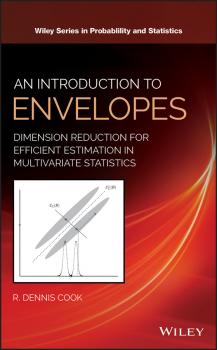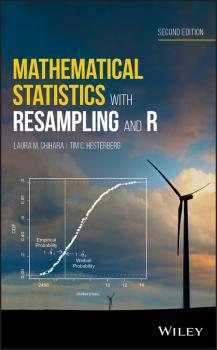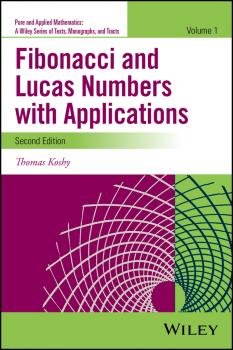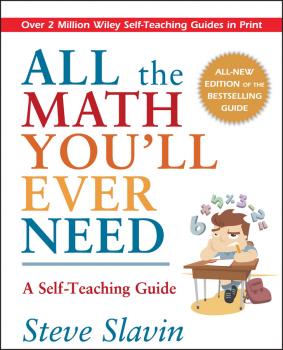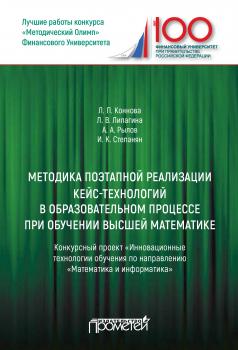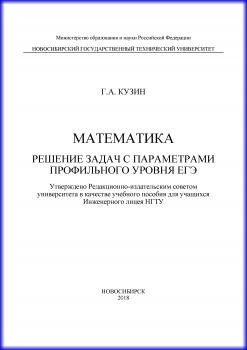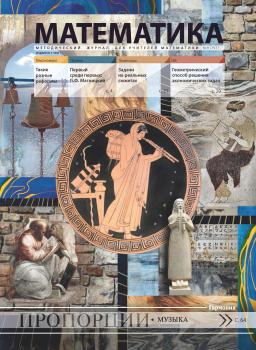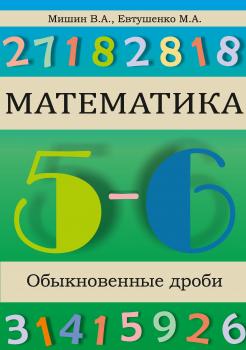ТОП просматриваемых книг сайта:
Математика
Различные книги в жанре Математика, доступные для чтения и скачиванияAn Introduction to Envelopes. Dimension Reduction for Efficient Estimation in Multivariate Statistics - R. Cook Dennis
Аннотация
Written by the leading expert in the field, this text reviews the major new developments in envelope models and methods An Introduction to Envelopes provides an overview of the theory and methods of envelopes, a class of procedures for increasing efficiency in multivariate analyses without altering traditional objectives. The author offers a balance between foundations and methodology by integrating illustrative examples that show how envelopes can be used in practice. He discusses how to use envelopes to target selected coefficients and explores predictor envelopes and their connection with partial least squares regression. The book reveals the potential for envelope methodology to improve estimation of a multivariate mean. The text also includes information on how envelopes can be used in generalized linear models, regressions with a matrix-valued response, and reviews work on sparse and Bayesian response envelopes. In addition, the text explores relationships between envelopes and other dimension reduction methods, including canonical correlations, reduced-rank regression, supervised singular value decomposition, sufficient dimension reduction, principal components, and principal fitted components. This important resource: • Offers a text written by the leading expert in this field • Describes groundbreaking work that puts the focus on this burgeoning area of study • Covers the important new developments in the field and highlights the most important directions • Discusses the underlying mathematics and linear algebra • Includes an online companion site with both R and Matlab support Written for researchers and graduate students in multivariate analysis and dimension reduction, as well as practitioners interested in statistical methodology, An Introduction to Envelopes offers the first book on the theory and methods of envelopes.
Аннотация
This thoroughly updated second edition combines the latest software applications with the benefits of modern resampling techniques Resampling helps students understand the meaning of sampling distributions, sampling variability, P-values, hypothesis tests, and confidence intervals. The second edition of Mathematical Statistics with Resampling and R combines modern resampling techniques and mathematical statistics. This book has been classroom-tested to ensure an accessible presentation, uses the powerful and flexible computer language R for data analysis and explores the benefits of modern resampling techniques. This book offers an introduction to permutation tests and bootstrap methods that can serve to motivate classical inference methods. The book strikes a balance between theory, computing, and applications, and the new edition explores additional topics including consulting, paired t test, ANOVA and Google Interview Questions. Throughout the book, new and updated case studies are included representing a diverse range of subjects such as flight delays, birth weights of babies, and telephone company repair times. These illustrate the relevance of the real-world applications of the material. This new edition: • Puts the focus on statistical consulting that emphasizes giving a client an understanding of data and goes beyond typical expectations • Presents new material on topics such as the paired t test, Fisher's Exact Test and the EM algorithm • Offers a new section on «Google Interview Questions» that illustrates statistical thinking • Provides a new chapter on ANOVA • Contains more exercises and updated case studies, data sets, and R code Written for undergraduate students in a mathematical statistics course as well as practitioners and researchers, the second edition of Mathematical Statistics with Resampling and R presents a revised and updated guide for applying the most current resampling techniques to mathematical statistics.
Аннотация
Praise for the First Edition “ …beautiful and well worth the reading … with many exercises and a good bibliography, this book will fascinate both students and teachers.” Mathematics Teacher Fibonacci and Lucas Numbers with Applications, Volume I, Second Edition provides a user-friendly and historical approach to the many fascinating properties of Fibonacci and Lucas numbers, which have intrigued amateurs and professionals for centuries. Offering an in-depth study of the topic, this book includes exciting applications that provide many opportunities to explore and experiment. In addition, the book includes a historical survey of the development of Fibonacci and Lucas numbers, with biographical sketches of important figures in the field. Each chapter features a wealth of examples, as well as numeric and theoretical exercises that avoid using extensive and time-consuming proofs of theorems. The Second Edition offers new opportunities to illustrate and expand on various problem-solving skills and techniques. In addition, the book features: • A clear, comprehensive introduction to one of the most fascinating topics in mathematics, including links to graph theory, matrices, geometry, the stock market, and the Golden Ratio • Abundant examples, exercises, and properties throughout, with a wide range of difficulty and sophistication • Numeric puzzles based on Fibonacci numbers, as well as popular geometric paradoxes, and a glossary of symbols and fundamental properties from the theory of numbers • A wide range of applications in many disciplines, including architecture, biology, chemistry, electrical engineering, physics, physiology, and neurophysiology The Second Edition is appropriate for upper-undergraduate and graduate-level courses on the history of mathematics, combinatorics, and number theory. The book is also a valuable resource for undergraduate research courses, independent study projects, and senior/graduate theses, as well as a useful resource for computer scientists, physicists, biologists, and electrical engineers. Thomas Koshy, PhD, is Professor Emeritus of Mathematics at Framingham State University in Massachusetts and author of several books and numerous articles on mathematics. His work has been recognized by the Association of American Publishers, and he has received many awards, including the Distinguished Faculty of the Year. Dr. Koshy received his PhD in Algebraic Coding Theory from Boston University. “Anyone who loves mathematical puzzles, number theory, and Fibonacci numbers will treasure this book. Dr. Koshy has compiled Fibonacci lore from diverse sources into one understandable and intriguing volume, [interweaving] a historical flavor into an array of applications.” Marjorie Bicknell-Johnson
Аннотация
A sharp mind, like a healthy body, is subject to the same rule of nature: Use it or lose it Need a calculator just to work out a 15 percent service charge? Not exactly sure how to get the calculator to give you the figure you need? Turn to this revised and updated edition of All the Math You'll Ever Need, the friendliest, funniest, and easiest workout program around. In no time, you'll have total command of all the powerful mathematical tools needed to make numbers work for you. In a dollars-and-cents, bottom-line world, where numbers influence everything, none of us can afford to let our math skills atrophy. This step-by-step personal math trainer: Refreshes practical math skills for your personal and professional needs, with examples based on everyday situations. Offers straightforward techniques for working with decimals and fractions. Demonstrates simple ways to figure discounts, calculate mortgage interest rates, and work out time, rate, and distance problems. Contains no complex formulas and no unnecessary technical terms.
Методика поэтапной реализации кейс-технологий в образовательном процессе при обучении высшей математике: Конкурсный проект «Инновационные технологии обучения по направлению „Математика и информатика“» - А. А. Рылов
Аннотация
Содержит методические материалы проекта победителей традиционного конкурса методического мастерства Финансового университета при Правительстве РФ «Методический олимп». Описана методика реализации азов технологии кейс-стади в преподавании базовых математических дисциплин будущим экономистам и менеджерам. Соответствует требованиям Федерального государственного образовательного стандарта высшего образования последнего поколения и Образовательным стандартам Финансового университета при Правительстве РФ по направлениям подготовки «Экономика» и «Менеджмент». Для преподавателей базовых дисциплин бакалавриата по направлениям подготовки «Экономика» и «Менеджмент». Может использоваться слушателями курсов повышения квалификации и переподготовки кадров, а также читателями, самостоятельно изучающими экономическую науку.
Аннотация
Задачи с параметрами из ЕГЭ требуют знания различных методов их решения. В учебном пособии приведены типовые примеры задач с подробными решениями с использованием графического метода и методов подвижных границ и областей. Ко всем задачам даны ответы или указания к решению. Пособие предназначено для учащихся 10–11 классов Инженерного лицея НГТУ и может быть использовано для проведения аудиторных занятий, а также при подготовке к ЕГЭ по математике.
Аннотация
Если вы интересуетесь математикой и физикой и любите решать задачи, то вашим другом и помощником станет научно-популярный физико-математический журнал «КВАНТ». Он выходит с 1970 года и рассчитан на школьников старших классов и их учителей, а также на студентов младших курсов. На страницах журнала – рассказы о достижениях науки и ее применениях, творческие задачи, истории замечательных идей и замечательных людей, головоломки, занятия факультативов и кружков, помощь в трудных вопросах школьной программы, интересные физические опыты, материалы для поступающих, задачи турниров и олимпиад по математике и физике (от городских до международных), полезная информация о научных обществах учащихся, физико-математических турнирах и праздниках, заочных и вечерних школах при различных вузах страны. А задачи раздела «Квант» для младших школьников» обычно интересны всем – от шестиклассников до академиков. В номере: Нам пишут Еще раз о построении касательной «Квант» для младших школьников «Призрачные» трубы. Школа в «Кванте» Как сухое трение стало вязким. Математический кружок Оклейка тетраэдра шестиугольниками. Калейдоскоп «Кванта» Астрофизика Наши наблюдения Трение против гравитации. и многое другое
Математика. Методический журнал для учителей математики. №09/2018 - Отсутствует
Журнал «Математика» 2018Аннотация
«Математика» – методический журнал для учителей математики. До 2017 года он 24 года входил в число периодических изданий Издательского дома «Первое сентября», а теперь издается Московским центром непрерывного математического образования при участии Российской ассоциации учителей математики. В журнале публикуются статьи о работе региональных отделений Российской ассоциации учителей математики, о международных исследованиях качества математической подготовки, по истории математики, методические материалы для подготовки к ЕГЭ (базовый и профильный уровни), для повышения квалификации учителей, для кружковых занятий, разборы уроков, головоломки. Журнал издается с 1992 г., выходит 10 раз в год. В номере: После уроков / Проект Первый среди первых: Л. Ф. Магницкий Методобъединение / Исторический практикум Полвека реформирования математического образования Методобъединение / Практикум Задачи на реальных сюжетах На уроке / ГИА Геометрический способ решения экономических задач После урока / В кладовой головоломок Бабушкины пироги В кабинете математики / На стенд Пропорции / Музыка и многое другое
Аннотация
В книге собраны задания как на действия с обыкновенными дробями, так и примеры, направленные на подготовку к изучению данной темы. В частности, в пособии приводятся задачи на признаки делимости, нахождение наибольшего общего делителя, нахождение наименьшего общего кратного и др. Материал, представленный в этой книге, служит для формирования устойчивых вычислительных навыков, которые необходимы современному школьнику. Приведенные задачи можно использовать для отработки навыка самопроверки, для различных соревнований, конкурсов, для дифференцированного обучения и т. п. Книга будет полезна учителям при подготовке к урокам, учащимся и их родителям.
Каникулы с пользой. Летние задачи по занимательной математике - Творческий коллектив программы «Хочу всё знать»
Хочу всё знать. Развитие мышления (радио «Маяк»)Аннотация
Вместе с директором «Новой школы», преподавателем математики Кириллом Медведевым решали занимательные математические задачки. – Едут два поезда навстречу другу другу каждый со скоростью 50 ка в час, расстояние между ними в данный момент 200 км. Между ними отчаянная муха летает от одного лобового стекла до другого со скоростью 75 км в час. Сколько км пролетит муха до встречи поездов? И много других задач на сообразительность.
Информация о книге
Автор произведения Творческий коллектив программы «Хочу всё знать»
Жанр Математика

